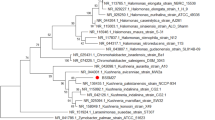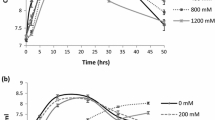Abstract
Increase in soil salinity adversely affects the metabolism and lowers the yield of rice (Oryza sativa L). Application of plant growth-promoting rhizobacteria (PGPR) to ameliorate the effects of salt stress on sensitive rice can be both effective and sustainable. In this study, 20 bacterial strains were isolated from the soil of saline-prone regions of Satkhira, north of the Sundarbans in coastal Bangladesh. Three bacteria among these grew well in the presence of 3 M salt (NaCl) and were Gram positive and non-motile. Their 16S rRNA sequence revealed that they belong to the Halobacillus genus. Two of them were identified as Halobacillus dabanensis strain SB-26 and the other one as Halobacillus sp. GSP 34. A couple of mechanisms by which these microbes could play beneficial role if associated with plants, such as nitrogen fixation and indole acetic acid (IAA) production, were identified. The two bacterial strains showed positive results for nitrogen fixation and indole acetic acid (IAA) activity under salt stress. Their effect on the physiology and yield of a farmer popular but sensitive BRRI dhan 28 rice variety was investigated under both control and salt stress. At the seedling stage, inoculated plants had significantly greater root length, shoot height, total weight, chlorophyll content, but lower electrolyte leakage both in control and salt stress (0, 40, and 80 mM). Performance of the plants was even better when both bacteria were used in combination. At the reproductive stage, the plants also showed better phenology in presence of the inoculated bacteria. Under stress (50 mM NaCl), these plants showed significantly greater plant height, lower spikelet damage, and yield reduction compared to untreated plants. The identified Halobacillus strains can therefore be used to improve the yield of rice by exploiting their plant growth promotion activities in coastal areas affected by moderate salinity, such as those with an ionic conductivity of up to 5 dS m−1.







Similar content being viewed by others
References
Bal HB, Nayak L, Das S, Adhya TK (2013) Isolation of ACC deaminase producing PGPR from rice rhizosphere and evaluating their plant growth promoting activity under salt stress. Plant Soil 366:93–105
Barnawal D, Bharti N, Maji D, Chanotiya CS, Kalra A (2014) ACC deaminase-containing Arthrobacter protophormiae induces NaCl stress tolerance through reduced ACC oxidase activity and ethylene production resulting in improved nodulation and mycorrhization in Pisum sativum. J Plant Physiol 171:884–894
Bashan Y, de-Bashan LE, Prabhu S, Hernandez J-P (2014) Advances in plant growth-promoting bacterial inoculant technology: formulations and practical perspectives (1998–2013). Plant Soil 378:1–33
Bhise KK, Bhagwat PK, Dandge PB (2017) Plant growth-promoting characteristics of salt tolerant Enterobacter cloacae strain KBPD and its efficacy in amelioration of salt stress in Vigna radiata L. J Plant Growth Regul 36:215–226
Bric JM, Bostock RM, Silverstone SE (1991) Rapid in situ assay for indoleacetic acid production by bacteria immobilized on a nitrocellulose membrane. Appl Environ Microbiol 57:535–538
Cao W-H, Liu J, He X-J, Mu R-L, Zhou H-L, Chen S-Y, Zhang J-S (2007) Modulation of ethylene responses affects plant salt-stress responses. Plant Physiol 143:707–719
Corwin DL (2003) Soil salinity measurement encyclopedia of water science. Marcel Dekker, New York, pp 852–860
de Souza Silva CMM, Fay EF (2012) Effect of salinity on soil microorganisms. INTECH Open Access Publisher,
Dasgupta S, Hossain M, Huq M, Wheeler D (2014) Climate change, soil salinity, and the economics of high-yield rice production in coastal Bangladesh
Dasgupta S, Hossain MM, Huq M, Wheeler D (2018) Climate change, salinization and high-yield Rice production in coastal Bangladesh. Agricultural Res Economics Rev 47:66–89
Glick BR (2012) Plant growth-promoting bacteria: mechanisms and applications Scientifica 2012
Glick BR, Todorovic B, Czarny J, Cheng Z, Duan J, McConkey B (2007) Promotion of plant growth by bacterial ACC deaminase. Crit Rev Plant Sci 26:227–242
Gopalakrishnan S et al (2012) Plant growth-promoting traits of biocontrol potential bacteria isolated from rice rhizosphere. SpringerPlus 1:71
Gots JS, Buchanan R, Gibbons N (1975) Bergey's manual of determinative bacteriology. JSTOR,
Gregorio GB, Senadhira D, Mendoza RD (1997a) Screening rice for salinity tolerance International Rice Research Institute discussion paper series
Gregorio GB, Senadhira D, Mendoza RD (1997b) Screening rice for salinity tolerance. IRRI discussion paper series,
Han Q-Q et al (2014a) Beneficial soil bacterium Bacillus subtilis (GB03) augments salt tolerance of white clover. Front Plant Sci 5:525
Han Q-Q et al. (2014b) Beneficial soil bacterium Bacillus subtilis (GB03) augments salt tolerance of white clover Front Plant Sci 5
Hoang TML, Tran TN, Nguyen TKT, Williams B, Wurm P, Bellairs S, Mundree S (2016) Improvement of salinity stress tolerance in rice: challenges and opportunities. Agronomy 6:54
Hossain M, Jaim W, Alam MS, Rahman A (2013) Rice biodiversity in Bangladesh
Jnandabhiram C, Sailen Prasad B (2012) Water stress effects on leaf growth and chlorophyll content but not the grain yield in traditional rice (Oryza sativa Linn.) genotypes of Assam, India II. Protein and proline status in seedlings under PEG induced water stress American Journal of Plant Sciences 2012
Khan A, Hossain MT, Park HC, Yun D-J, Shim SH, Chung YR (2016) Development of root system architecture of Arabidopsis thaliana in response to colonization by Martelella endophytica YC6887 depends on auxin signaling. Plant Soil 405:81–96
Kjeldahl J (1883) A new method for the determination of nitrogen in organic matter. Z Anal Chem 22:366–382
Kuan KB, Othman R, Rahim KA, Shamsuddin ZH (2016) Plant growth-promoting rhizobacteria inoculation to enhance vegetative growth, nitrogen fixation and nitrogen remobilisation of maize under greenhouse conditions. PLoS One 11:e0152478
Kumar A, Maurya B, Raghuwanshi R (2014) Isolation and characterization of PGPR and their effect on growth, yield and nutrient content in wheat (Triticum aestivum L.). Biocatalysis Agricultural Biotechnology 3:121–128
Lippi D, Cacciari I, Pietrosanti T, Quatrini P (1992) Interactions between Azospirillum and Arthrobacter in diazotrophic mixed culture Symbiosis 13:107–114
Lisa LA et al (2004) Genetic variation in microsatellite DNA, physiology and morphology of coastal saline rice (Oryza sativa L.) landraces of Bangladesh. Plant Soil 263:213–228
Madhaiyan M, Poonguzhali S, Sa T (2007) Characterization of 1-aminocyclopropane-1-carboxylate (ACC) deaminase containing Methylobacterium oryzae and interactions with auxins and ACC regulation of ethylene in canola (Brassica campestris). Planta 226:867–876
Misra AK (2014) Climate change and challenges of water and food security. Int J Sustainable Built Environ 3:153–165
Moradi F, Ismail AM (2007) Responses of photosynthesis, chlorophyll fluorescence and ROS-scavenging systems to salt stress during seedling and reproductive stages in rice. Ann Bot 99:1161–1173
Nackley LL, Barnes C, Oki LR (2015) Investigating the impacts of recycled water on long-lived conifers. AoB Plants 7:plv035
Nakbanpote W, Panitlurtumpai N, Sangdee A, Sakulpone N, Sirisom P, Pimthong A (2014) Salt-tolerant and plant growth-promoting bacteria isolated from Zn/cd contaminated soil: identification and effect on rice under saline conditions. J Plant Interact 9:379–387
Nautiyal CS, Srivastava S, Chauhan PS, Seem K, Mishra A, Sopory SK (2013) Plant growth-promoting bacteria Bacillus amyloliquefaciens NBRISN13 modulates gene expression profile of leaf and rhizosphere community in rice during salt stress. Plant Physiol Biochem 66:1–9
Orhan F, Gulluce M (2015) Isolation and characterization of salt-tolerant bacterial strains in salt-affected soils of Erzurum, Turkey. Geomicrobiol J 32:521–529
Park M, Kim C, Yang J, Lee H, Shin W, Kim S, Sa T (2005) Isolation and characterization of diazotrophic growth promoting bacteria from rhizosphere of agricultural crops of Korea. Microbiol Res 160:127–133
Parvin S, Biswas S, Razzaque S, Haque T, Elias SM, Tammi RS, Seraj ZI (2015) Salinity and drought tolerance conferred by in planta transformation of SNAC1 transcription factor into a high-yielding rice variety of Bangladesh. Acta Physiol Plant 37:1–12
Paul D, Lade H (2014) Plant-growth-promoting rhizobacteria to improve crop growth in saline soils: a review. Agron Sustain Dev 34:737–752
Paul D, Nair S (2008) Stress adaptations in a plant growth promoting rhizobacterium (PGPR) with increasing salinity in the coastal agricultural soils. J Basic Microbiol 48:378–384
Rahman SS, Siddique R, Tabassum N (2017) Isolation and identification of halotolerant soil bacteria from coastal Patenga area. BMC Res Notes 10:531
Redfern SK, Azzu N, Binamira JS (2012) Rice in Southeast Asia: facing risks and vulnerabilities to respond to climate change. In: Meybeck A et al. (eds) Building resilience for adaptation to climate change in the agriculture sector. FAO, Proceedings of a Joint FAO/OECD Workshop, Rome, pp 295–314
Rousk J, Bååth E (2007) Fungal and bacterial growth in soil with plant materials of different C/N ratios. FEMS Microbiol Ecol 62:258–267
Sahoo RK, Ansari MW, Pradhan M, Dangar TK, Mohanty S, Tuteja N (2014) A novel Azotobacter vinellandii (SRI Az 3) functions in salinity stress tolerance in rice. Plant Signaling Behavior 9:511–523
Sambrook J, Russell DW (2001) Molecular cloning: a laboratory manual 3rd edition Coldspring-Harbour Laboratory Press, UK
Seefeldt LC, Hoffman BM, Dean DR (2009) Mechanism of Mo-dependent nitrogenase. Annu Rev Biochem 78:701–722
Selote DS, Khanna-Chopra R (2004) Drought-induced spikelet sterility is associated with an inefficient antioxidant defence in rice panicles. Physiol Plant 121:462–471
Shrivastava P, Kumar R (2015) Soil salinity: a serious environmental issue and plant growth promoting bacteria as one of the tools for its alleviation. Saudi J Biological Sci 22:123–131
Siddikee MA, Chauhan P, Anandham R, Han G-H, Sa T (2010) Isolation, characterization, and use for plant growth promotion under salt stress, of ACC deaminase-producing halotolerant bacteria derived from coastal soil. J Microbiol Biotechnol 20:1577–1584
Singh RP, Jha P, Jha PN (2015) The plant-growth-promoting bacterium Klebsiella sp. SBP-8 confers induced systemic tolerance in wheat (Triticum aestivum) under salt stress. J Plant Physiol 184:57–67
Souza Rd, Ambrosini A, Passaglia LM (2015) Plant growth-promoting bacteria as inoculants in agricultural soils. Genet Mol Biol 38:401–419
Ström L, Owen AG, Godbold DL, Jones DL (2005) Organic acid behaviour in a calcareous soil implications for rhizosphere nutrient cycling. Soil Biol Biochem 37:2046–2054
Walkley A (1947) A critical examination of a rapid method for determining organic carbon in soils-effect of variations in digestion conditions and of inorganic soil constituents. Soil Sci 63:251–264
Yan N, Marschner P, Cao W, Zuo C, Qin W (2015) Influence of salinity and water content on soil microorganisms. Int Soil Water Conservation Res 3:316–323
Zhang W, Feng Y (2008) Characterization of nitrogen-fixing moderate halophilic cyanobacteria isolated from saline soils of Songnen plain in China. Prog Nat Sci 18:769–773
Zhang B, Lu WD, Yang SS (2006) Protein expression analysis of Halobacillus dabanensis D-8 T subjected to salt shock. J Microbiol 44:369–374
Zhao B, Lu W, Yang L, Zhang B, Wang L, Yang SS (2006) Cloning and characterization of the genes for biosynthesis of the compatible solute ectoine in the moderately halophilic bacterium Halobacillus dabanensis D-8T. Curr Microbiol 53:183–188
Acknowledgments
This work was supported by the grant to Z.I.S. by the Ministry of Science and Technology. We would like to thank Raju Ahmed for taking care of rice plants in the net house at DU.
Author information
Authors and Affiliations
Contributions
All authors contributed significantly to this study. FR and SB performed isolation techniques, molecular identification, did some plant growth promotion activities, comparative physiology, compiled the data, and did statistical analyses. MRI helped in those techniques. PS helped in doing physiological screening both in seedling and reproductive stages. ZIS designed the study and helped in writing the manuscript.
Corresponding author
Electronic supplementary material
ESM 1
(DOCX 1824 kb)
Rights and permissions
About this article
Cite this article
Rima, F.S., Biswas, S., Sarker, P.K. et al. Bacteria endemic to saline coastal belt and their ability to mitigate the effects of salt stress on rice growth and yields. Ann Microbiol 68, 525–535 (2018). https://doi.org/10.1007/s13213-018-1358-7
Received:
Accepted:
Published:
Issue Date:
DOI: https://doi.org/10.1007/s13213-018-1358-7




